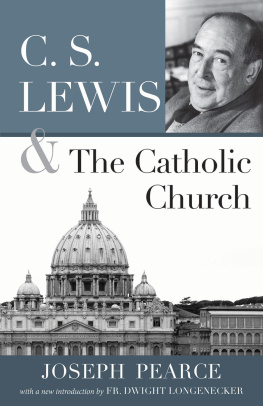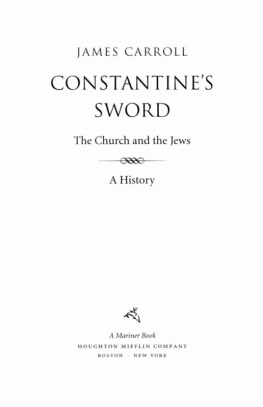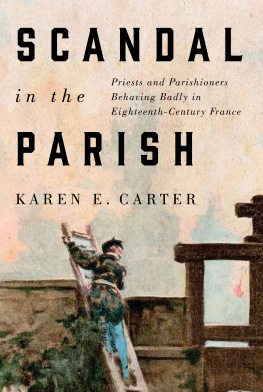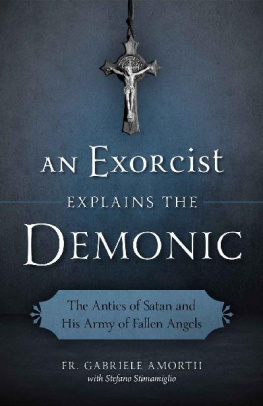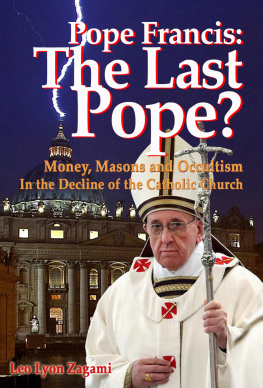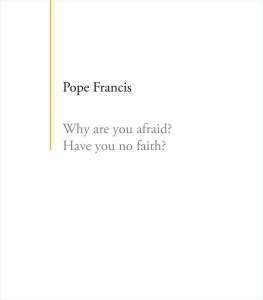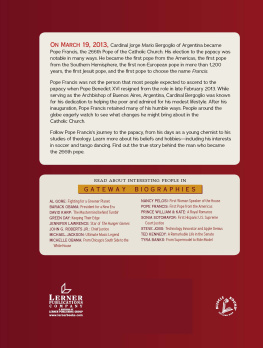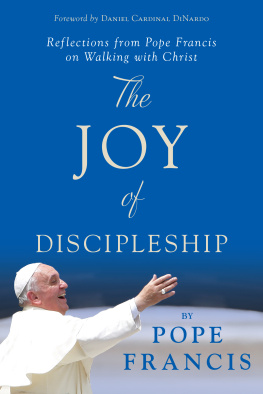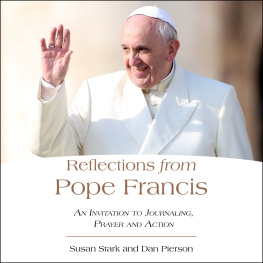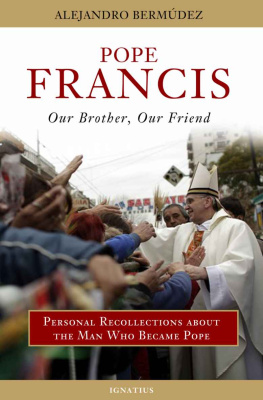In Your Eyes I See My Words

Copyright 2019 Fordham University Press
This book was originally published in Italian as Jorge Mario Bergoglio, Papa Francesco, Nei tuoi occhi la mia parola: Omelie e discorsi di Buenos Aires, 19992013, Introduzione e cura di Antonio Spadaro S.I. 2016 Rizzoli Libri S.p.A / Rizzoli, Milan.
The translation could not have been possible without the generous donations from Charles F. and Helen A. Dolan and Dr. and Mrs. William Baker.
All rights reserved. No part of this publication may be reproduced, stored in a retrieval system, or transmitted in any form or by any meanselectronic, mechanical, photocopy, recording, or any otherexcept for brief quotations in printed reviews, without the prior permission of the publisher.
Fordham University Press has no responsibility for the persistence or accuracy of URLs for external or third-party Internet websites referred to in this publication and does not guarantee that any content on such websites is, or will remain, accurate or appropriate.
Fordham University Press also publishes its books in a variety of electronic formats. Some content that appears in print may not be available in electronic books.
Visit us online at www.fordhampress.com.
Library of Congress Cataloging-in-Publication Data available online at https://catalog.loc.gov.
Printed in the United States of America
21 20 19 5 4 3 2 1
First edition
Library of Congress Cataloging-in-Publication Data
Names: Francis, Pope, 1936 author. | Spadaro, Antonio, editor. | Herrera, Marina, translator.
Title: In your eyes I see my words : homilies and speeches from Buenos Aires / Jorge Mario Bergoglio, Pope Francis ; edited by Antonio Spadaro ; translated by Marina A. Herrera ; introduction translated by Elena Buia Rutt and Andrew Rutt
Other titles: Sermons. Selections. English
Description: New York : Fordham University Press, 2019. | This book was originally published in Italian as Jorge Mario Bergoglio, Papa Francesco, Nei tuoi occhi la mia parola: Omelie e discorsi di Buenos Aires. | Includes bibliographical references and index. | Contents: Volume 1: 1999 to 2004 | Summary: Pope Francis was a first in many ways: the first pope from the Americas, the first Jesuit, the first Francis, the first child of immigrants from the old world, nurtured and transformed by the new world, and returned to lead the whole world. His eloquent homilies and speeches have inspired the faithful of Argentina for decades, largely through his gift of oratory, tracing back to his time as a bishop, archbishop, and cardinal in his home country. To be published in English for the first time in their entirety and with contextual annotations, In Your Eyes I See My Words, Volume 1, collects his homilies and speeches from 1999 to 2004. Volume II spans from 20052008, and Volume III, from 20092013, concludes with his prophetic last homily before being elected to the papacyProvided by publisher.
Identifiers: LCCN 2019028502 | ISBN 9780823285600 (hardback) | ISBN 9780823285617 (ebook)
Subjects: LCSH: Catholic ChurchSermons.
Classification: LCC BX1756.F677 S4713 2019 | DDC 252/.02dc23
LC record available at https://lccn.loc.gov/2019028502
The last page of this book is a continuation of this copyright page.
Contents
PATRICK J. RYAN, S.J.
ANTONIO SPADARO, S.J.
MARINA A. HERRERA
Patrick J. Ryan, S.J.
I preach regularly on Sundays at a parish on the Upper West Side of Manhattan. When I sometimes wax more than ordinarily academic, I tell the congregation that they can apply for credit from Fordham University if they pay the requisite tuition.
The Vatican reporter John Allen reported that Pope Francis, speaking at a Wednesday audience early in 2018, had some words of advice especially made for me: The homily is not a casual discourse, nor a conference or a lesson. In the course of the same Wednesday audience, Francis told a story that can serve as a warning for all who preach. A priest said to me once that he had gone to another city, where his parents lived. His dad told him, You know, Im happy, because me and my friends found a church where they do the Mass without a homily. How many times have we seen people sleeping during a homily, or chatting among themselves, or outside smoking a cigarette? When people laughed at the image, Francis said, Its true, you all know it its true! Concluding that line of reflection, Francis said, Please be brief no more than 10 minutes, please!
As one who has seen his own first cousins in rural Ireland ducking out for a cigarette while he was preaching for much less than ten minutes, I have learned that brevity is the soul of homiletic wit. Even in more patient New York City, I seldom exceed Pope Franciss time limit. The babies in the congregation can serve all of us preachers as timers.
In his 2013 Apostolic Exhortation, Evangelii gaudium , a sketch of the themes he hoped to emphasize in his years of papal service, Pope Francis had already suggested, provocatively, that the homily is a maternal form of communication. The Church is a mother, and she preaches in the same way that a mother speaks to her child, knowing that the child trusts that what she is teaching is for his or her benefit, for children know that they are loved. Moreover, a good mother can recognize everything that God is bringing about in her children, she listens to their concerns and learns from them. Like every good mother, the homilist should never nag, and especially the homilist should never nag at great length.
In this first volume of his pre-papal homilies and discourses, the former Archbishop of Buenos AiresPapa Bergoglio, as the Italian press calls him todayshares with us some notably succinct homilies. The down-to-earth style of these homilies should not deceive the casual reader. There is depth of insight as well as pastoral wisdom everywhere. In a Chrism Mass at which he presided and preached during Holy Week of 1999 in Buenos Aires, Bergoglio urged the clergy gathered with him for that annual liturgical event to take seriously the symbolism of all anointing in the Church: the anointing of candidates for baptism and confirmation, the anointing of the seriously sick, the anointing of deacons, priests, and bishops as they take up their roles of service:
By anointing the reviled and glorified body of his beloved Son, God our Father has anointed all our sufferings and our joys. Therefore, our hands anointed with chrism should be hands close to our faithful people, hands that make them feel in their flesh the anointing of the Father, especially where that fleshwhich is ours!is hungry and thirsty, is sick and wounded, is atoning for its sins in prison, has nothing to wear, knows the bitter diminishment of loneliness born of contempt.
The longer discourses from Papa Bergoglios pre-Roman daysnot homilies during liturgical celebrations, but addresses at conferences organized for various constituenciesexamine with great insight the so-called postmodern situation. Speaking in 1999 to a conference of business executives interested in education, Bergoglio decried certain elements of the modern cultural and intellectual situation: Postmodern culture presents a model of person that is strongly associated with the image of young people. Those who look young are beautiful, who undergo treatments to have the traces of time disappear. The model of beauty is a youthful model, informal, casual . Our model of adulthood is an adolescent. The limitations of such worship of youth, such disregard for the wisdom of the past, are many. A year later, in a message delivered to Argentinian Catholic educators, Bergoglio called for a humanistic education that deepens people in their cultural past: But will it be that the postmodern disenchantment, present not only in politics but also in culture, art, and everyday life, brings down with it every glimpse of hope based on the expectation of the kingdom?
Next page

